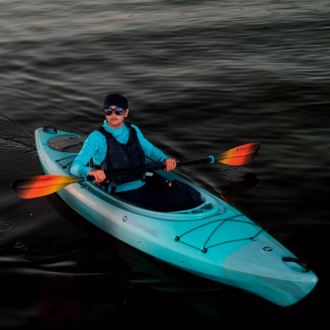Kayak hull shapes and lengths offer distinct benefits based on specific preferences and intended uses.
Hull shapes:
- Flat Hull: Provides excellent stability, making it ideal for beginners and calm water conditions. Suitable for leisurely paddling, fishing, and exploring tranquil lakes or slow-moving rivers.
- Rounded Hull: Offers increased manoeuvrability and responsiveness, making it suitable for navigating narrow channels, rocky areas, and fast-flowing rivers. Excels in quick turns and agile movements.
- V-Shaped Hull: Designed for speed and efficiency, cutting through the water with ease. Ideal for long-distance expeditions, sea kayaking, and racing. Offers excellent tracking and glides efficiently through waves.
Kayak lengths:
- Shorter Kayaks: Provide increased manoeuvrability, making them suitable for tight spaces or situations where quick turns are necessary. Easier to transport and store, making them ideal for people with limited space.
- Longer Kayaks: Offer better tracking and stability in open water. Maintain a straighter course and glide more efficiently, making them suitable for touring, expeditions, and coastal paddling. Ideal for those seeking endurance and stability on long journeys.
Choosing the right hull shape and length depends on personal preferences, skill level, intended activities, and the type of water conditions one expects to encounter.
In addition to hull shapes and lengths, another important consideration when choosing a kayak is the chine type, which refers to the transition between the bottom of the hull and the sides. There are two main types of chine: hard chine and soft chine, each offering distinct characteristics.
- Hard Chine: Kayaks with a hard chine have a more pronounced and angular transition between the bottom and sides of the hull. This design provides increased initial stability, meaning the kayak feels more stable when at rest or in calm conditions. Hard chine kayaks tend to have a more defined edge, which can enhance the boat’s tracking ability and provide a solid platform for edging and manoeuvring.
- Soft Chine: Kayaks with a soft chine have a smoother, more rounded transition between the bottom and sides of the hull. This design offers improved secondary stability, which refers to the kayak’s ability to maintain balance when tilted or in rougher water. Soft chine kayaks have a gentler edge, which allows for smoother turns and manoeuvrability.
The choice between hard chine and soft chine kayaks depends on the paddler’s skill level, intended activities, and personal preferences. Hard chine kayaks excel in stability and control, making them suitable for whitewater or situations where manoeuvrability is crucial. Soft chine kayaks prioritize secondary stability and smoother performance, making them ideal for sea kayaking, touring, and longer expeditions
.
Ultimately, understanding the benefits and characteristics of different chine types, in conjunction with hull shapes and lengths, allows paddlers to make an informed decision that aligns with their specific needs and aspirations on the water.

 Kayaks, Canoes, SUPs
Kayaks, Canoes, SUPs Accesories
Accesories